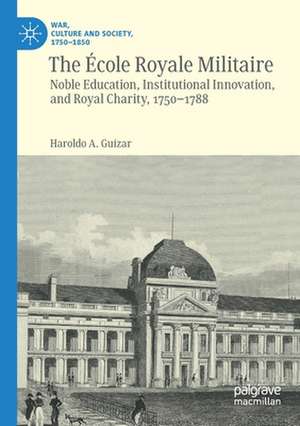The École Royale Militaire: Noble Education, Institutional Innovation, and Royal Charity, 1750-1788: War, Culture and Society, 1750–1850
Autor Haroldo A. Guízaren Limba Engleză Paperback – 25 aug 2021
| Toate formatele și edițiile | Preț | Express |
|---|---|---|
| Paperback (1) | 681.45 lei 6-8 săpt. | |
| Springer International Publishing – 25 aug 2021 | 681.45 lei 6-8 săpt. | |
| Hardback (1) | 686.74 lei 6-8 săpt. | |
| Springer International Publishing – 25 aug 2020 | 686.74 lei 6-8 săpt. |
Din seria War, Culture and Society, 1750–1850
- 20%
 Preț: 691.13 lei
Preț: 691.13 lei - 15%
 Preț: 680.81 lei
Preț: 680.81 lei - 15%
 Preț: 690.92 lei
Preț: 690.92 lei - 15%
 Preț: 686.43 lei
Preț: 686.43 lei - 15%
 Preț: 575.34 lei
Preț: 575.34 lei - 15%
 Preț: 627.93 lei
Preț: 627.93 lei - 15%
 Preț: 525.03 lei
Preț: 525.03 lei -
 Preț: 380.92 lei
Preț: 380.92 lei - 15%
 Preț: 631.92 lei
Preț: 631.92 lei - 15%
 Preț: 686.74 lei
Preț: 686.74 lei - 15%
 Preț: 634.32 lei
Preț: 634.32 lei - 15%
 Preț: 691.70 lei
Preț: 691.70 lei -
 Preț: 192.85 lei
Preț: 192.85 lei -
 Preț: 377.34 lei
Preț: 377.34 lei -
 Preț: 388.66 lei
Preț: 388.66 lei - 18%
 Preț: 708.74 lei
Preț: 708.74 lei - 15%
 Preț: 632.73 lei
Preț: 632.73 lei - 18%
 Preț: 775.86 lei
Preț: 775.86 lei - 18%
 Preț: 714.78 lei
Preț: 714.78 lei - 15%
 Preț: 630.33 lei
Preț: 630.33 lei -
 Preț: 388.44 lei
Preț: 388.44 lei -
 Preț: 380.33 lei
Preț: 380.33 lei - 15%
 Preț: 684.81 lei
Preț: 684.81 lei - 15%
 Preț: 633.36 lei
Preț: 633.36 lei -
 Preț: 197.93 lei
Preț: 197.93 lei - 15%
 Preț: 685.11 lei
Preț: 685.11 lei - 15%
 Preț: 629.19 lei
Preț: 629.19 lei -
 Preț: 376.22 lei
Preț: 376.22 lei - 18%
 Preț: 772.15 lei
Preț: 772.15 lei - 18%
 Preț: 877.30 lei
Preț: 877.30 lei - 15%
 Preț: 680.00 lei
Preț: 680.00 lei - 18%
 Preț: 715.56 lei
Preț: 715.56 lei
Preț: 681.45 lei
Preț vechi: 801.71 lei
-15% Nou
Puncte Express: 1022
Preț estimativ în valută:
130.45€ • 135.80$ • 107.40£
130.45€ • 135.80$ • 107.40£
Carte tipărită la comandă
Livrare economică 01-15 februarie 25
Preluare comenzi: 021 569.72.76
Specificații
ISBN-13: 9783030459338
ISBN-10: 3030459330
Pagini: 301
Ilustrații: XVII, 301 p. 1 illus. in color.
Dimensiuni: 148 x 210 mm
Greutate: 0.38 kg
Ediția:1st ed. 2020
Editura: Springer International Publishing
Colecția Palgrave Macmillan
Seria War, Culture and Society, 1750–1850
Locul publicării:Cham, Switzerland
ISBN-10: 3030459330
Pagini: 301
Ilustrații: XVII, 301 p. 1 illus. in color.
Dimensiuni: 148 x 210 mm
Greutate: 0.38 kg
Ediția:1st ed. 2020
Editura: Springer International Publishing
Colecția Palgrave Macmillan
Seria War, Culture and Society, 1750–1850
Locul publicării:Cham, Switzerland
Cuprins
1. Financing and Administering the Ecole Militaire: Its Origins, Evolution and Demise, 1750-1793.- 2. Debating Socio-Military Reform: The Defence of the Ecole Militaire as an Institutional Solution to the Predicaments of the Nobility.- 3. The École Militaire’s Curriculum – Its Antecedents and Conception.- 4. Testing Theory at the Ecole Militaire: The Implementation and Modification of Curricular Concepts, 1753-1785.- 5. Beneficent Paternalism: The Ecole Militaire as a Charitable Institution.
Notă biografică
Haroldo Guízar is an independent scholar.
Textul de pe ultima copertă
This book explores the Paris Ecole Militaire as an institution, arguing for its importance as a school that presented itself as a model for reform during a key moment in the movement towards military professionalism as well as state-run secular education. The school is distinguished for being an Enlightenment project, one of its founders publishing an article on it in the Encyclopédie in 1755. Its curriculum broke completely with the Latin pedagogy of the dominant Jesuit system, while adapting the legacy of seventeenth-century riding academies. Its status touches on the nature of absolutism, as it was conceived to glorify the Bourbon dynasty in a similar way to the girls’ school at Saint Cyr and the Invalides. It was also a dispensary of royal charity calculated to ally the nobility more closely to royal interests through military service. In the army, its proofs of nobility were the model for the much debated 1781 Ségur decree, often described as a notable cause of the French Revolution.
Caracteristici
Ex?plores the Paris Ecole Militaire as an institution, arguing for its importance as a school that presented itself as a model for reform Examines the importance of the school within the movement towards military professionalism as well as state-run secular education Bridges the chasm between histories of education and histories of military reform and brings the two fields into dialogue
